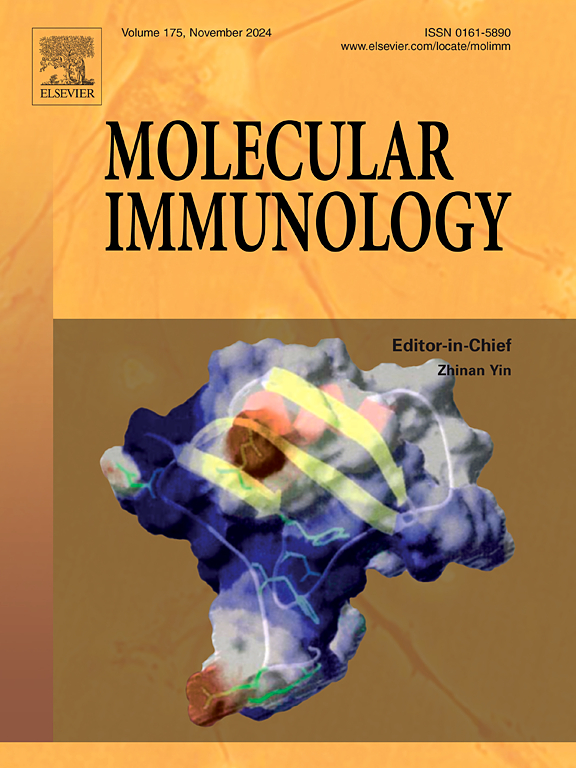Total free lipids from MDR strain of Mycobacterium tuberculosis “M” reduce T cell activation and CTL activity in healthy individuals
IF 3
3区 医学
Q2 BIOCHEMISTRY & MOLECULAR BIOLOGY
引用次数: 0
Abstract
Increasing evidence highlights the role of cell wall components in the effectiveness of different Mycobacterium tuberculosis (Mtb) strains in modulating host immune response. We previously demonstrated that the outbreak multidrug-resistant strain M displays a distinctive lipid profile in its cell envelope compared to the closely related sporadic strain 410. Both strains markedly differ in their ability to induce fully functional CD8+ T cells because of low CD69 signaling and impaired CD4+ T cell help. In this study, we evaluated the impact of extractable lipids (LP) from M (LP-M) and 410 (LP-410) on the activation and functionality of T cells from healthy individuals. PBMCs were cultured alone or with Mtb in the presence or absence of LP-M, LP-410, or LP from CD1551 mutants in polymorphic genes between M and 410. Then, surface CD69 and intracytoplasmic IL-2 (after 3 days of culture), as well as surface CD107 expression (after 6 days of culture) were determined in T cells by flow cytometry. In contrast to LP-410, LP-M induced low expression of CD69 and IL-2 in CD4+/CD8+ cells and of CD107 in CD8+ cells. Besides, LP from Mtb strains mutated in Rv1861c and Rv3787c genes inhibited H37Rv-induced T cell response without causing cell death. Thus, our results suggest that LP-M likely through mutations in Rv1861 and Rv3787c, inhibits the activation and functionality of T cells from PPD+ healthy human donors and might partially contribute to the development of immune evasion mechanisms in the M strain.
MDR结核分枝杆菌“M”株总游离脂质降低健康个体T细胞活化和CTL活性
越来越多的证据强调细胞壁成分在不同结核分枝杆菌(Mtb)菌株调节宿主免疫反应中的作用。我们之前已经证明,与密切相关的散发性菌株410相比,暴发多重耐药菌株M在其细胞包膜中显示出独特的脂质谱。由于低CD69信号和CD4+ T细胞帮助受损,这两种菌株在诱导全功能CD8+ T细胞的能力上显着不同。在这项研究中,我们评估了从M (LP-M)和410 (LP-410)中提取的脂质(LP)对健康个体T细胞激活和功能的影响。在M和410之间多态基因的CD1551突变体存在或不存在LP-M、LP-410或LP的情况下,pbmc单独或与Mtb一起培养。然后用流式细胞术检测T细胞表面CD69和胞浆内IL-2(培养3 d后)以及表面CD107的表达(培养6 d后)。与LP-410相比,LP-M诱导CD4+/CD8+细胞中CD69和IL-2的低表达,CD8+细胞中CD107的低表达。此外,Rv1861c和Rv3787c基因突变的Mtb菌株的LP抑制了h37rv诱导的T细胞反应而不引起细胞死亡。因此,我们的研究结果表明,LP-M可能通过Rv1861和Rv3787c的突变,抑制PPD+ 健康人类供体T细胞的激活和功能,并可能部分促进M菌株免疫逃避机制的发展。
本文章由计算机程序翻译,如有差异,请以英文原文为准。
求助全文
约1分钟内获得全文
求助全文
来源期刊

Molecular immunology
医学-免疫学
CiteScore
6.90
自引率
2.80%
发文量
324
审稿时长
50 days
期刊介绍:
Molecular Immunology publishes original articles, reviews and commentaries on all areas of immunology, with a particular focus on description of cellular, biochemical or genetic mechanisms underlying immunological phenomena. Studies on all model organisms, from invertebrates to humans, are suitable. Examples include, but are not restricted to:
Infection, autoimmunity, transplantation, immunodeficiencies, inflammation and tumor immunology
Mechanisms of induction, regulation and termination of innate and adaptive immunity
Intercellular communication, cooperation and regulation
Intracellular mechanisms of immunity (endocytosis, protein trafficking, pathogen recognition, antigen presentation, etc)
Mechanisms of action of the cells and molecules of the immune system
Structural analysis
Development of the immune system
Comparative immunology and evolution of the immune system
"Omics" studies and bioinformatics
Vaccines, biotechnology and therapeutic manipulation of the immune system (therapeutic antibodies, cytokines, cellular therapies, etc)
Technical developments.
 求助内容:
求助内容: 应助结果提醒方式:
应助结果提醒方式:


